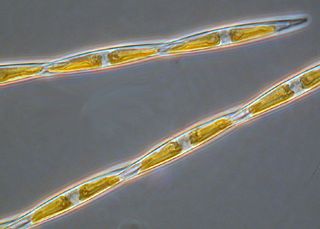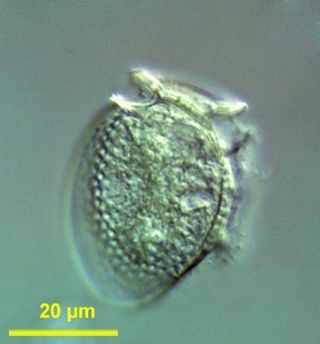Related Research Articles

A toxin is a naturally occurring organic poison produced by metabolic activities of living cells or organisms. They occur especially as proteins, often conjugated. The term was first used by organic chemist Ludwig Brieger (1849–1919) and is derived from the word "toxic".

An algal bloom or algae bloom is a rapid increase or accumulation in the population of algae in freshwater or marine water systems. It is often recognized by the discoloration in the water from the algae's pigments. The term algae encompasses many types of aquatic photosynthetic organisms, both macroscopic multicellular organisms like seaweed and microscopic unicellular organisms like cyanobacteria. Algal bloom commonly refers to the rapid growth of microscopic unicellular algae, not macroscopic algae. An example of a macroscopic algal bloom is a kelp forest.

Domoic acid (DA) is a kainic acid-type neurotoxin that causes amnesic shellfish poisoning (ASP). It is produced by algae and accumulates in shellfish, sardines, and anchovies. When sea lions, otters, cetaceans, humans, and other predators eat contaminated animals, poisoning may result. Exposure to this compound affects the brain, causing seizures, and possibly death.

Cyanotoxins are toxins produced by cyanobacteria. Cyanobacteria are found almost everywhere, but particularly in lakes and in the ocean where, under high concentration of phosphorus conditions, they reproduce exponentially to form blooms. Blooming cyanobacteria can produce cyanotoxins in such concentrations that they can poison and even kill animals and humans. Cyanotoxins can also accumulate in other animals such as fish and shellfish, and cause poisonings such as shellfish poisoning.

Saxitoxin (STX) is a potent neurotoxin and the best-known paralytic shellfish toxin (PST). Ingestion of saxitoxin by humans, usually by consumption of shellfish contaminated by toxic algal blooms, is responsible for the illness known as paralytic shellfish poisoning (PSP).
Okadaic acid, C44H68O13, is a toxin produced by several species of dinoflagellates, and is known to accumulate in both marine sponges and shellfish. One of the primary causes of diarrhetic shellfish poisoning, okadaic acid is a potent inhibitor of specific protein phosphatases and is known to have a variety of negative effects on cells. A polyketide, polyether derivative of a C38 fatty acid, okadaic acid and other members of its family have shined light upon many biological processes both with respect to dinoflagellete polyketide synthesis as well as the role of protein phosphatases in cell growth.

Many species of fish are caught by humans and consumed as food in virtually all regions around the world. Fish has been an important dietary source of protein and other nutrients.

Paralytic shellfish poisoning (PSP) is one of the four recognized syndromes of shellfish poisoning, which share some common features and are primarily associated with bivalve mollusks. These shellfish are filter feeders and accumulate neurotoxins, chiefly saxitoxin, produced by microscopic algae, such as dinoflagellates, diatoms, and cyanobacteria. Dinoflagellates of the genus Alexandrium are the most numerous and widespread saxitoxin producers and are responsible for PSP blooms in subarctic, temperate, and tropical locations. The majority of toxic blooms have been caused by the morphospecies Alexandrium catenella, Alexandrium tamarense, Gonyaulax catenella and Alexandrium fundyense, which together comprise the A. tamarense species complex. In Asia, PSP is mostly associated with the occurrence of the species Pyrodinium bahamense.
Shellfish poisoning includes four syndromes that share some common features and are primarily associated with bivalve molluscs As filter feeders, these shellfish may accumulate toxins produced by microscopic algae, such as cyanobacteria, diatoms and dinoflagellates.

Neurotoxic shellfish poisoning (NSP) is caused by the consumption of brevetoxins, which are marine toxins produced by the dinoflagellate Karenia brevis. These toxins can produce a series of gastrointestinal and neurological effects. Outbreaks of NSP commonly take place following harmful algal bloom (HAB) events, commonly referred to as "Florida red tide". Algal blooms are a naturally-occurring phenomenon, however their frequency has been increasing in recent decades at least in-part due to human activities, climate changes, and the eutrophication of marine waters. HABs have been occurring for all of documented history, evidenced by the Native Americans' understanding of the dangers of shellfish consumption during periods of marine bioluminescence. Blooms have been noted to occur as far north as North Carolina and are commonly seen alongside the widespread death of fish and sea birds. In addition to the effects on human health, the economic impact of HAB-associated shellfish toxin outbreaks can have significant economic implications as well due to not only the associated healthcare costs, but the adverse impact on the commercial shellfish industry.

A harmful algal bloom (HAB), or excessive algae growth, is an algal bloom that causes negative impacts to other organisms by production of natural algae-produced toxins, mechanical damage to other organisms, or by other means. HABs are sometimes defined as only those algal blooms that produce toxins, and sometimes as any algal bloom that can result in severely lower oxygen levels in natural waters, killing organisms in marine or fresh waters. Blooms can last from a few days to many months. After the bloom dies, the microbes that decompose the dead algae use up more of the oxygen, generating a "dead zone" which can cause fish die-offs. When these zones cover a large area for an extended period of time, neither fish nor plants are able to survive. Harmful algal blooms in marine environments are often called "red tides".
The Shellfish Association of Great Britain (SAGB) is a historic association that was founded as the Oyster Merchants' and Planters' Association in 1903, it was renamed the SAGB in 1969. They cover a wide range of topics within the shellfish industry, from trading to advice on nutritional standards and also the sustainability of the industry.

Nitzschia is a common pennate marine diatom. In the scientific literature, this genus, named after Christian Ludwig Nitzsch, is sometimes referred to incorrectly as Nitzchia, and it has many species described, which all have a similar morphology. In its current circumscription, Nitzschia is paraphyletic.

Pseudo-nitzschia is a marine planktonic diatom genus that accounts for 4.4% of pennate diatoms found worldwide. Some species are capable of producing the neurotoxin domoic acid (DA), which is responsible for the neurological disorder in humans known as amnesic shellfish poisoning (ASP). Currently, 58 species are known, 28 of which have been shown to produce DA. It was originally hypothesized that only dinoflagellates could produce harmful algal toxins, but a deadly bloom of Pseudo-nitzschia occurred in 1987 in the bays of Prince Edward Island, Canada, and led to an outbreak of ASP. Over 100 people were affected by this outbreak after consuming contaminated mussels; three people died. Since this event, no additional deaths have been attributed to ASP, though the prevalence of toxic diatoms and DA has increased worldwide. This anomaly is likely due to increased awareness of harmful algal blooms (HABs) and their implications for human and ecosystem health.

Yessotoxins are a group of lipophilic, sulfur bearing polyether toxins that are related to ciguatoxins. They are produced by a variety of dinoflagellates, most notably Lingulodinium polyedrum and Gonyaulax spinifera.
Phycotoxins are complex allelopathic chemicals produced by eukaryotic and prokaryotic algal secondary metabolic pathways. More simply, these are toxic chemicals synthesized by photosynthetic organisms. These metabolites are not harmful to the producer but may be toxic to either one or many members of the marine food web. This page focuses on phycotoxins produced by marine microalgae; however, freshwater algae and macroalgae are known phycotoxin producers and may exhibit analogous ecological dynamics. In the pelagic marine food web, phytoplankton are subjected to grazing by macro- and micro-zooplankton as well as competition for nutrients with other phytoplankton species. Marine bacteria try to obtain a share of organic carbon by maintaining symbiotic, parasitic, commensal, or predatory interactions with phytoplankton. Other bacteria will degrade dead phytoplankton or consume organic carbon released by viral lysis. The production of toxins is one strategy that phytoplankton use to deal with this broad range of predators, competitors, and parasites. Smetacek suggested that "planktonic evolution is ruled by protection and not competition. The many shapes of plankton reflect defense responses to specific attack systems". Indeed, phytoplankton retain an abundance of mechanical and chemical defense mechanisms including cell walls, spines, chain/colony formation, and toxic chemical production. These morphological and physiological features have been cited as evidence for strong predatory pressure in the marine environment. However, the importance of competition is also demonstrated by the production of phycotoxins that negatively impact other phytoplankton species. Flagellates are the principle producers of phycotoxins; however, there are known toxigenic diatoms, cyanobacteria, prymnesiophytes, and raphidophytes. Because many of these allelochemicals are large and energetically expensive to produce, they are synthesized in small quantities. However, phycotoxins are known to accumulate in other organisms and can reach high concentrations during algal blooms. Additionally, as biologically active metabolites, phycotoxins may produce ecological effects at low concentrations. These effects may be subtle, but have the potential to impact the biogeographic distributions of phytoplankton and bloom dynamics.

Azaspiracids (AZA) are a group of polycyclic ether marine algal toxins produced by the small dinoflagellate Azadinium spinosum that can accumulate in shellfish and thereby cause illness in humans.

Dinophysis acuminata is a marine plankton species of dinoflagellates that is found in coastal waters of the north Atlantic and Pacific oceans. The genus Dinophysis includes both phototrophic and heterotrophic species. D. acuminata is one of several phototrophic species of Dinophysis classed as toxic, as they produce okadaic acid which can cause diarrhetic shellfish poisoning (DSP). Okadiac acid is taken up by shellfish and has been found in the soft tissue of mussels and the liver of flounder species. When contaminated animals are consumed, they cause severe diarrhoea. D. acuminata blooms are constant threat to and indication of diarrhoeatic shellfish poisoning outbreaks.
Pseudo-nitzschia australis is a pennate diatom found in temperate and sub-tropic marine waters, such as off the coast of California and Argentina. This diatom is a Harmful Micro Algae that produces toxic effects on a variety of organisms through its production of domoic acid, a neurotoxin. Toxic effects have been observed in a variety of predatory organisms such as pelicans, sea lions, and humans. If exposed to a high enough dose, these predators will die as a result, and there is no known antidote. The potential indirect mortality associated with P. australis is of great concern to humans as toxic algae blooms, including blooms of P. australis, continue to increase in frequency and severity over recent years. Blooms of P. australis are believed to result from high concentrations of nitrates and phosphates in stream and river runoff, as well as coastal upwelling, which are also sources of other harmful algae blooms.
Greta Albrecht Fryxell was a marine scientist known for her work on the biology and taxonomy of diatoms. In 1996, she was elected a fellow of the American Association for the Advancement of Science.
References
- 1 2 3 Clark, R. F.; Williams, S. R.; Nordt, S. P.; Manoguerra, A. S. (1999). "A Review of Selected Seafood Poisonings". Undersea and Hyperbaric Medicine. 26 (3): 175–184. PMID 10485519. Archived from the original on 2011-08-11. Retrieved 2008-08-13.
{{cite journal}}: CS1 maint: unfit URL (link) - ↑ "IOC-UNESCO Taxonomic Reference List of Harmful Micro Algae (HABs)". Archived from the original on 2016-09-17. Retrieved 2012-05-17.Nitzschia navis-varingica
- ↑ Bates, S. S.; Trainer, V. L. (2006). "The Ecology of Harmful Diatoms". In Granéli, E.; Turner, J. (eds.). Ecology of Harmful Algae. Ecological Studies. Vol. 189. Heidelberg: Springer-Verlag. pp. 81–93. doi:10.1007/978-3-540-32210-8_7. ISBN 978-3-540-74009-4.
- ↑ Bejarano, A. C.; van Dola, F. M.; Gulland, F. M.; Rowles, T. K.; Schwacke, L. H. (2008). "Production and Toxicity of the Marine Biotoxin Domoic Acid and its Effects on Wildlife: A Review" (PDF). Human and Ecological Risk Assessment. 14 (3): 544–567. doi:10.1080/10807030802074220. S2CID 51778319. Archived from the original (PDF) on 2016-06-29. Retrieved 2012-05-17.
- ↑ Trainer, V. L.; Hickey, B. M.; Bates, S. S. (2008). "Toxic Diatoms". In Walsh, P. J.; Smith, S. L.; Fleming, L. E.; Solo-Gabriele, H.; Gerwick, W. H. (eds.). Oceans and Human Health: Risks and Remedies from the Sea. New York: Elsevier Science. pp. 219–237. ISBN 978-0-12-372584-4.
- ↑ Lefebvre, K. A.; Robertson, A. (2010). "Domoic Acid and Human Exposure Risks: A Review". Toxicon. 56 (2): 218–230. doi:10.1016/j.toxicon.2009.05.034. PMID 19505488.
- ↑ Bargu, S.; Smith, E.; Ozhan, K. (2011). "Toxic Diatom Pseudo-nitzschia and its Primary Consumers (Vectors)". In Seckbach, J.; Kociolek, P. (eds.). The Diatom World. Springer. pp. 493–512. ISBN 978-9400713260.
- ↑ Bargu, S.; Goldstein, T.; Roberts, K.; Li, C.; Gulland, F. (2012). "Pseudo-nitzschia Blooms, Domoic Acid, and Related California Sea Lion Strandings in Monterey Bay, California". Marine Mammal Science. 28 (2): 237–253. doi:10.1111/j.1748-7692.2011.00480.x.
- ↑ Lelong, A.; Hégaret, H.; Soudant, P.; Bates, S. S. (2012). "Pseudo-nitzschia (Bacillariophyceae) Species, Domoic Acid and Amnesic Shellfish Poisoning: Revisiting Previous Paradigms". Phycologia. 51 (2): 168–216. doi:10.2216/11-37.1. S2CID 55094773.
- ↑ Trainer, V. L.; Bates, S. S.; Lundholm, N.; Thessen, A. E.; Cochlan, W. P.; Adams, N. G.; Trick, C. G. (2012). "Pseudo-nitzschia Physiological Ecology, Phylogeny, Toxicity, Monitoring and Impacts on Ecosystem Health". Harmful Algae. 14: 271–300. doi:10.1016/j.hal.2011.10.025. hdl: 1912/5118 .
- ↑ Ramsdell, J. S. (2007). "The Molecular and Integrative Basis to Domoic Acid Toxicity". In Botana, L. (ed.). Phycotoxins: Chemistry and Biochemistry. Cambridge, MA: Wiley-Blackwell. pp. 223–250. doi:10.1002/9780470277874.ch13. ISBN 978-0-8138-2700-1.
- ↑ Pulido, O. M. (2008). "Domoic Acid Toxicologic Pathology: A Review" (PDF). Marine Drugs. 6 (2): 180–219. doi: 10.3390/md20080010 . PMC 2525487 . PMID 18728725.
- ↑ Bates, S. S.; et al. (1989). "Pennate diatom Nitzschia pungens as the primary source of domoic acid, a toxin in shellfish from eastern Prince Edward Island, Canada". Canadian Journal of Fisheries and Aquatic Sciences. 46 (7): 1203–1215. doi:10.1139/f89-156.
- ↑ Todd, E. C. D. (1993). "Domoic Acid and Amnesic Shellfish Poisoning: A Review". Journal of Food Protection. 56 (1): 69–83. doi: 10.4315/0362-028X-56.1.69 . PMID 31084045. Archived from the original on 2020-09-21. Retrieved 2012-07-10.
- ↑ Quilliam M. A.; Wright J. L. C. (1989). "The Amnesic Shellfish Poisoning Mystery". Analytical Chemistry. 61 (18): 1053A–1060A. doi:10.1021/ac00193a002. PMID 2802153. S2CID 40176293.
- ↑ C. J. Bird et al., Identification of Domoic Acid as the Toxic Agent Responsible for the P.E.I. Contaminated Mussel Incident, Atlantic Research Laboratory Technical Report series, № 56 (Halifax: National Research Council of Canada [NRC], July 1988), NRC Publications Archive Record 491ebf1a-8091-4f6c-ae50-0bc144108c94, doi : 10.4224/23000874.
- ↑ "Possibly drunk pelican hits windshield". NBC News . 24 June 2006. Archived from the original on 2017-03-16.
- ↑ Domic Acid Information and History Archived May 13, 2009, at the Wayback Machine
- ↑ Bargu, S.; Silver, M. W.; Ohman, M. D.; Benitez-Nelson, C. R.; Garrison, D. L. (2012). "Mystery behind Hitchcock's Birds". Nature Geoscience. 5 (1): 2–3. Bibcode:2012NatGe...5....2B. doi: 10.1038/ngeo1360 .
